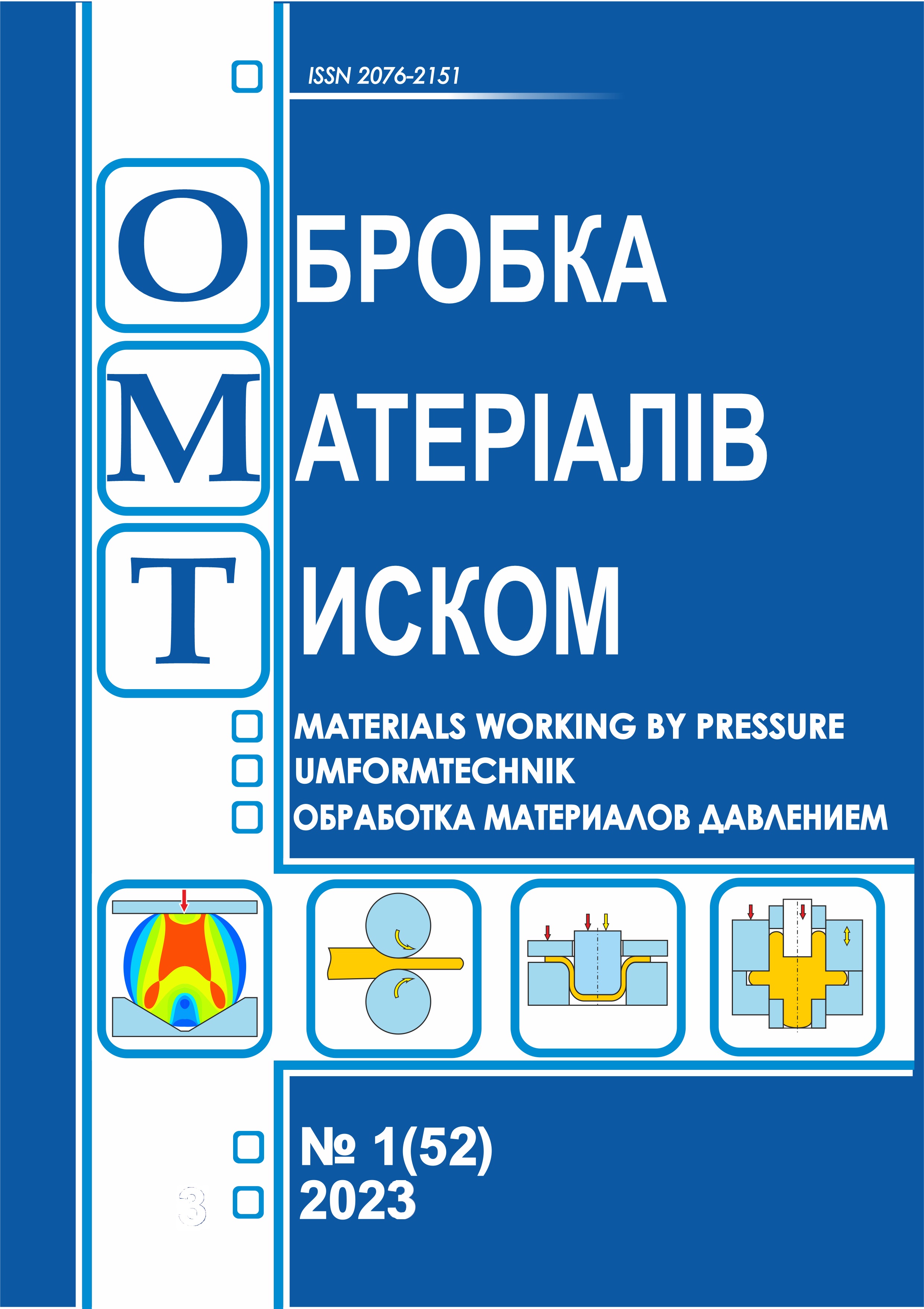Radial-longitudinal extrusion of parts with a flange and a ledge
DOI:
https://doi.org/10.37142/2076-2151/2023-1(52)95Keywords:
parts with flange and ledge, combined radial-longitudinal extrusion, movable die, stress-strain state, finite element method, workpiece forming.Abstract
Levchenko V., Alieva L., Abhari P., Sivak R. Radial-longitudinal extrusion of parts with a flange and a ledge.
Methods for manufacturing hollow and rod axisymmetric parts with a flange and an axial ledge by extrusion are considered. Depending on the design and parameters of the part, two groups of predominantly accepted methods of combined extrusion are distinguished: radial-backward and radial-forward extrusion. The results of modeling the process of combined radial-reverse extrusion of a rod part with a flange by the finite element method using the Q-Form software package are presented. It has been confirmed that with combined extrusion of a part with a flange and a ledge with metal outflow in the radial and forward directions in a fixed matrix, the plastic deformation zone is combined. In this case, the flange formed by radial extrusion can become a stagnant zone along which the metal will move in the forward direction. This causes the risk of breaking the part and separating the flange. The new method of combined extrusion in a movable matrix involves the separation of metal extrusion centers in the radial and direct directions from the beginning of the process. An assessment is made of the regularities of shape change and development of the deformed state of the workpiece in the process of combined extrusion in a movable matrix. It is found that the mobility of the die prevents the danger of separation of the flange. At the same time, the concentration of zones with the most intense deformation at the outlet holes on the transitional edges of the shaping tool is maintained. Comparison of the deformed state of the workpiece obtained by the finite element method with experimental data obtained by the dividing grid method showed a close nature of the deformation fields in the plastic zone.
References
Aliiev I.S., Hrudkina N.S., Malii Kh.V., Tahan L.V. Modeling and development of precision volumetric extrusion stamping processes: monograph. Kramatorsk: DSEA. 2021. 208 p. ISBN 978-617-7889-08-2. (In Ukrainian).
Bhaduri A. Extrusion. In: Mechanical Properties and Working of Metals and Alloys. Springer Series in Materials Science. 2018. 264, pp. 599-646. https://doi.org/10.1007/978-981-10-7209-3_13
Balendra, R., Qin, Y. Injection forging: engineering and research. Journal of Material Processing. 2004. 145, 189-206.
Aliev I.S. Radial extrusion process. Soviet Forging and Metal Stamping Technology (English Translation of Kuznechno-Shtampovochnoe Proizvodstvo). 1988. Part 3, pp. 54–61, ISSN: 0891-334x.
Aliiev I.S. Technological possibilities of new methods of combined extrusion. Forging and stamping pro-duction. 1990. No. 2. pp. 7-9. (in Russian).
Aliieva L. I. Improvement of combined extrusion processes: monograph. Kramatorsk: LLC "Tiraj – 51". 2018. 352 p. ISBN 978-966-379-846-2. (in Russian).
Aliiev I., Aliieva L., Grudkina N., Zhbankov Ya. Prediction of the variation of the form in the processes of extrusion. Metallurgical and Mining Industry. 2011. 3(7), pp. 17–22. https://www.metaljournal.com.ua/assets/Uploads/attachments/17Aliiev.pdf
Aliieva L.I., Borisov R.S., Zhbankov Ya.G., Moroz B.S. Combined extrusion of hollow parts with a flange. Improvement of processes and equipment for pressure treatment in mechanical engineering and metallurgy. Kramatorsk: DSEA. 2008, pp. 45-48. (in Russian).
Aliieva L.I., Markov O.Y., Aliiev I.S., Hrudkina N.S., Levchenko V.N., Malii Kh.V. Analysis of power pa-rameters of the combined three-direction extrusion process. FME Transactions. 2021. 49. 2, pp. 344–355. https://www.mas.bg.ac.rs/_media/istrazivanje/fme/vol49/2/9_oe_markov_et_al.pdf
Lee H.Y., Hwang B. B., Lee S. H. Forming load and deformation energy in combined radial backward ex-trusion process. Proceedings of the Int. Conf. “Metal Forming 2012”. 16-19.09.2012. AGH. Krakow, pp. 487–490.
Lee Y. S., Hwang S. K., Chang Y. S., Hwang B. B. The forming characteristics of radial-forward extru-sion. Journal of materials processing technology. 2001. 113, pp. 136–140. https://doi.org/10.1016/S0924-0136(01)00705-1
Farhoumand A., Ebrahimi R. Analysis of forward-backward-radial extrusion process. Materials and De-sign. 2009. 30. 6, pp. 2152–2157. https://doi.org/10.1016/j.matdes.2008.08.025
Jafarzadeh H., Zadshakoyan M., & Abdi Sobbouhi E. Numerical studies of some important design factors in radial–forward extrusion process. Materials and Manufacturing Processes. 2010. 25, pp. 857–863. https://doi.org/10.1080/10426910903536741
Chang Y.S., Hwang B.B. A study on the forming characteristics of radial extrusions combined with for-ward extrusion. Transactions of materials processing. 2000. 9. 3, pp. 242-248.
Biba N.V. Experience using QForm programs for modeling metal forming processes in industry, educa-tion and research. Plastic deformation of metals: Materials of scientific and practical conference, 22-26 may 2017. Dnipro. 2017, p. 9. (In Ukrainian).
Pat. 8620 Ukraine. B21K21/00. Sposіb vidavlyuvannya details zі foldable profile. L.I. Aliieva, R.S. Borisov. No. 200500452. app. 01/17/2005; publ. 08/15/2005. Bull. No. 8. (In Ukrainian).

